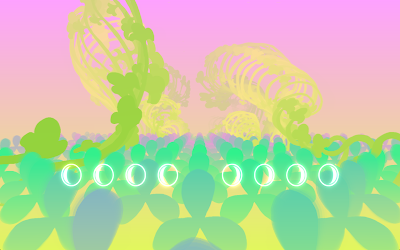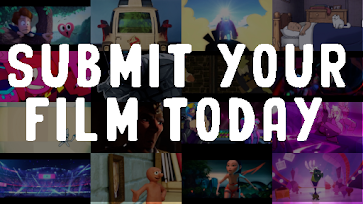In Conversation with Paloma Dawkins: Animator on 'ALEA'
Noah Tavlin, ANNY [Animation Nights New York] Correspondent to Animation For Adults, discussed indie game ALEA with animator Paloma Dawkins.
The name “ALEA” comes from the word Aleatoric, denoting music that leaves an element of interpretation up to its performers. This is an apt title for a rhythm game in which players can play along as they wish without penalization for missing cues and playing incorrect notes.
ALEA was released last year as a collaboration between animator Paloma Dawkins, programmer Cale Bradbury and musician Caila Thompson, who performs as Mozart’s Sister. The game offers three different hikes through psychedelic forests, in which you play along with the rhythm of the accompanying music. It’s like Guitar Hero or Rock Band for people who don’t drink energy drinks and love immersive animated worlds. ALEA has been featured on HumbleBundle, Fantastic Arcade, Day of Devs, BabyCastles and TCAF.
AFA: How did you think of the idea for ALEA?
Paloma Dawkins: I went hiking in woods outside of San Francisco. I was with a bunch of friends and I had a hard time watching my feet and watching the nature around me at the same time. I was following my friends and they were walking really fast. I don't think they really cared about the trail that much. They were more into speed. They were practically jogging. This hike inspired the redwood level in ALEA.
Were the other levels inspired by specific hikes as well?
Not really. The "Clover" level was just me testing things out and deciding that it looked cool. And the "Mushroom" level... I was just trying to be psychedelic.
So you created different elements for the levels and arranged them into the 2.5D space.
Yeah. Their animation interacts with the controls so I made four elements for each level. The four elements respond to the four different musical tones. Basically, the idea of the game is, you are God, walking through the world, controlling the moon, which is what the player controls. The different notes change the phases of the moon. The different phases of the moon affect the plant life in different ways.
What do you hope ALEA inspires people to do more of?
To think more about what it means to look at nature through a computer. Nature conquers everything, it's the source of everything. We make technology that mimics nature and we forget this constantly. The computer is a very natural thing. We get so sucked into it and then we think it’s a part of ourselves that isn't natural. But by creating a straightforward game about nature, and allowing users to affect them, the goal is to remind the player that nature is a really simple thing. I want people to slow down.
I'm also inspired by game tropes. There’s this basic assumption in gaming that you start a game so you can win. Or do well. In ALEA, there's no winning or losing. It's very un-punishing.
In ALEA, the player affects nature, but in a very gentle way. How do you feel we affect nature?
Well besides the obvious of killing it, I feel like we force nature to adapt to our needs. In the game you're making it just wiggle. It should be harmonious.
Who would you say this game is for?
This game is for people who want to relax. Not hardcore gamers. At a party I was presenting ALEA at, someone was like "Oh, is there Expert mode?" I don't know if I want to make an 'Expert mode' but maybe I'd make harder levels.
Expert mode seems against the spirit of the game.
Yeah exactly. It would be punishing.
What were the challenges to make this game? What did you have to figure out? What did you have to learn how to do?
I was working with a programmer [Cale Bradbury] who took care of all the programming so I could just focus on animation. But it took a lot of project management skills. We were working in different parts of the country. The biggest challenge was staying motivated and staying on the same page. It was a huge juggling act. Being able to execute an iterative approach to making games and fine-tune it is really difficult when you're not there to push and motivate each other.
Which came first—the music or the game?
They were made together. I would talk with Cale and Caila about which levels we would like to see. We would talk about them thoroughly. I'd say something like 'Wouldn't it be cool if there was a winding path through a bunch of trees that seems to go on forever?' and Kayla would say 'Yeah it would be cool if it had a good beat.' And we'd go on like that.
What was the process of designing the levels and the music simultaneously?
So the base track more or less didn't change. The challenge was making 'puzzles.' The puzzle is the rhythm that you're playing. We had to change this constantly. Sometimes it wasn't satisfying. Or it was too easy or too hard. There was a lot of back and forth on whose job it is to design the puzzles. I wanted the puzzles to go with the music, so I figured Caila would design the puzzles. But she didn't know whether or not they'd be fun to play. So then I started making the puzzles, and I'd check with her and see if she thought it sounded cool. She would edit it and we'd go back and forth.
This game would be amazing in VR. Have you thought about adapting it?
That would be so fun! But it would be hard to translate the controls. If this was in VR, it would make people... too crazy. People would just puke right away.
Paloma Dawkins is a Montreal-based animator, artist, and game designer. You can find her other work here, and you can follow her on Twitter here.
Noah Tavlin is a New York-based writer and Animation Nights New York Correspondent for AFA. You can follow Noah on Twitter here, and you can follow ANNY on Twitter and Facebook for more information about their monthly independent animation screenings.
The name “ALEA” comes from the word Aleatoric, denoting music that leaves an element of interpretation up to its performers. This is an apt title for a rhythm game in which players can play along as they wish without penalization for missing cues and playing incorrect notes.
ALEA was released last year as a collaboration between animator Paloma Dawkins, programmer Cale Bradbury and musician Caila Thompson, who performs as Mozart’s Sister. The game offers three different hikes through psychedelic forests, in which you play along with the rhythm of the accompanying music. It’s like Guitar Hero or Rock Band for people who don’t drink energy drinks and love immersive animated worlds. ALEA has been featured on HumbleBundle, Fantastic Arcade, Day of Devs, BabyCastles and TCAF.
AFA: How did you think of the idea for ALEA?
Paloma Dawkins: I went hiking in woods outside of San Francisco. I was with a bunch of friends and I had a hard time watching my feet and watching the nature around me at the same time. I was following my friends and they were walking really fast. I don't think they really cared about the trail that much. They were more into speed. They were practically jogging. This hike inspired the redwood level in ALEA.
Were the other levels inspired by specific hikes as well?
Not really. The "Clover" level was just me testing things out and deciding that it looked cool. And the "Mushroom" level... I was just trying to be psychedelic.
So you created different elements for the levels and arranged them into the 2.5D space.
Yeah. Their animation interacts with the controls so I made four elements for each level. The four elements respond to the four different musical tones. Basically, the idea of the game is, you are God, walking through the world, controlling the moon, which is what the player controls. The different notes change the phases of the moon. The different phases of the moon affect the plant life in different ways.
What do you hope ALEA inspires people to do more of?
To think more about what it means to look at nature through a computer. Nature conquers everything, it's the source of everything. We make technology that mimics nature and we forget this constantly. The computer is a very natural thing. We get so sucked into it and then we think it’s a part of ourselves that isn't natural. But by creating a straightforward game about nature, and allowing users to affect them, the goal is to remind the player that nature is a really simple thing. I want people to slow down.
I'm also inspired by game tropes. There’s this basic assumption in gaming that you start a game so you can win. Or do well. In ALEA, there's no winning or losing. It's very un-punishing.
In ALEA, the player affects nature, but in a very gentle way. How do you feel we affect nature?
Well besides the obvious of killing it, I feel like we force nature to adapt to our needs. In the game you're making it just wiggle. It should be harmonious.
Who would you say this game is for?
This game is for people who want to relax. Not hardcore gamers. At a party I was presenting ALEA at, someone was like "Oh, is there Expert mode?" I don't know if I want to make an 'Expert mode' but maybe I'd make harder levels.
Expert mode seems against the spirit of the game.
Yeah exactly. It would be punishing.
What were the challenges to make this game? What did you have to figure out? What did you have to learn how to do?
I was working with a programmer [Cale Bradbury] who took care of all the programming so I could just focus on animation. But it took a lot of project management skills. We were working in different parts of the country. The biggest challenge was staying motivated and staying on the same page. It was a huge juggling act. Being able to execute an iterative approach to making games and fine-tune it is really difficult when you're not there to push and motivate each other.
Which came first—the music or the game?
They were made together. I would talk with Cale and Caila about which levels we would like to see. We would talk about them thoroughly. I'd say something like 'Wouldn't it be cool if there was a winding path through a bunch of trees that seems to go on forever?' and Kayla would say 'Yeah it would be cool if it had a good beat.' And we'd go on like that.
What was the process of designing the levels and the music simultaneously?
So the base track more or less didn't change. The challenge was making 'puzzles.' The puzzle is the rhythm that you're playing. We had to change this constantly. Sometimes it wasn't satisfying. Or it was too easy or too hard. There was a lot of back and forth on whose job it is to design the puzzles. I wanted the puzzles to go with the music, so I figured Caila would design the puzzles. But she didn't know whether or not they'd be fun to play. So then I started making the puzzles, and I'd check with her and see if she thought it sounded cool. She would edit it and we'd go back and forth.
This game would be amazing in VR. Have you thought about adapting it?
That would be so fun! But it would be hard to translate the controls. If this was in VR, it would make people... too crazy. People would just puke right away.
Paloma Dawkins is a Montreal-based animator, artist, and game designer. You can find her other work here, and you can follow her on Twitter here.
Noah Tavlin is a New York-based writer and Animation Nights New York Correspondent for AFA. You can follow Noah on Twitter here, and you can follow ANNY on Twitter and Facebook for more information about their monthly independent animation screenings.

























